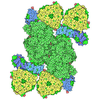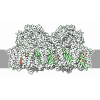[English] 日本語
 Yorodumi
Yorodumi- EMDB-6483: Mechanisms of Ribosome Stalling by SecM at Multiple Elongation Steps -
+ Open data
Open data
- Basic information
Basic information
| Entry | Database: EMDB / ID: EMD-6483 | |||||||||
|---|---|---|---|---|---|---|---|---|---|---|
| Title | Mechanisms of Ribosome Stalling by SecM at Multiple Elongation Steps | |||||||||
 Map data Map data | Cryo EM reconstruction of SecM-Gly-RNC (ribosomal-nascent-peptide-complex) with 50S-tRNA mask | |||||||||
 Sample Sample |
| |||||||||
 Keywords Keywords | electron microscopy / single particle analysis / ribosome stalling | |||||||||
| Function / homology |  Function and homology information Function and homology informationouter membrane protein complex / monoatomic ion transmembrane transporter activity / detection of virus / outer membrane / porin activity / pore complex / ornithine decarboxylase inhibitor activity / transcription antitermination factor activity, RNA binding / misfolded RNA binding / Group I intron splicing ...outer membrane protein complex / monoatomic ion transmembrane transporter activity / detection of virus / outer membrane / porin activity / pore complex / ornithine decarboxylase inhibitor activity / transcription antitermination factor activity, RNA binding / misfolded RNA binding / Group I intron splicing / RNA folding / transcriptional attenuation / endoribonuclease inhibitor activity / RNA-binding transcription regulator activity / positive regulation of ribosome biogenesis / negative regulation of cytoplasmic translation / four-way junction DNA binding / DnaA-L2 complex / monoatomic ion transport / translation repressor activity / negative regulation of DNA-templated DNA replication initiation / negative regulation of translational initiation / regulation of mRNA stability / mRNA regulatory element binding translation repressor activity / ribosome assembly / assembly of large subunit precursor of preribosome / positive regulation of RNA splicing / transcription elongation factor complex / cytosolic ribosome assembly / regulation of DNA-templated transcription elongation / DNA endonuclease activity / response to reactive oxygen species / transcription antitermination / regulation of cell growth / cell outer membrane / DNA-templated transcription termination / maintenance of translational fidelity / response to radiation / mRNA 5'-UTR binding / ribosomal small subunit biogenesis / small ribosomal subunit rRNA binding / large ribosomal subunit / ribosome biogenesis / ribosome binding / regulation of translation / ribosomal small subunit assembly / outer membrane-bounded periplasmic space / small ribosomal subunit / 5S rRNA binding / large ribosomal subunit rRNA binding / transferase activity / cytosolic small ribosomal subunit / ribosomal large subunit assembly / cytoplasmic translation / cytosolic large ribosomal subunit / tRNA binding / molecular adaptor activity / negative regulation of translation / rRNA binding / ribosome / structural constituent of ribosome / symbiont entry into host cell / ribonucleoprotein complex / translation / response to antibiotic / negative regulation of DNA-templated transcription / mRNA binding / DNA damage response / DNA binding / RNA binding / zinc ion binding / identical protein binding / membrane / cytosol / cytoplasm Similarity search - Function | |||||||||
| Biological species |  | |||||||||
| Method | single particle reconstruction / cryo EM / Resolution: 3.64 Å | |||||||||
 Authors Authors | Zhang J / Pan XJ / Yan KG / Sun S / Gao N / Sui SF | |||||||||
 Citation Citation |  Journal: Elife / Year: 2015 Journal: Elife / Year: 2015Title: Mechanisms of ribosome stalling by SecM at multiple elongation steps. Authors: Jun Zhang / Xijiang Pan / Kaige Yan / Shan Sun / Ning Gao / Sen-Fang Sui /  Abstract: Regulation of translating ribosomes is a major component of gene expression control network. In Escherichia coli, ribosome stalling by the C-terminal arrest sequence of SecM regulates the SecA- ...Regulation of translating ribosomes is a major component of gene expression control network. In Escherichia coli, ribosome stalling by the C-terminal arrest sequence of SecM regulates the SecA-dependent secretion pathway. Previous studies reported many residues of SecM peptide and ribosome exit tunnel are critical for stalling. However, the underlying molecular mechanism is still not clear at the atomic level. Here, we present two cryo-EM structures of the SecM-stalled ribosomes at 3.3-3.7 Å resolution, which reveal two different stalling mechanisms at distinct elongation steps of the translation cycle: one is due to the inactivation of ribosomal peptidyl-transferase center which inhibits peptide bond formation with the incoming prolyl-tRNA; the other is the prolonged residence of the peptidyl-RNA at the hybrid A/P site which inhibits the full-scale tRNA translocation. These results demonstrate an elegant control of translation cycle by regulatory peptides through a continuous, dynamic reshaping of the functional center of the ribosome. | |||||||||
| History |
|
- Structure visualization
Structure visualization
| Movie |
 Movie viewer Movie viewer |
|---|---|
| Structure viewer | EM map:  SurfView SurfView Molmil Molmil Jmol/JSmol Jmol/JSmol |
| Supplemental images |
- Downloads & links
Downloads & links
-EMDB archive
| Map data |  emd_6483.map.gz emd_6483.map.gz | 117 MB |  EMDB map data format EMDB map data format | |
|---|---|---|---|---|
| Header (meta data) |  emd-6483-v30.xml emd-6483-v30.xml emd-6483.xml emd-6483.xml | 16.4 KB 16.4 KB | Display Display |  EMDB header EMDB header |
| FSC (resolution estimation) |  emd_6483_fsc.xml emd_6483_fsc.xml | 11.3 KB | Display |  FSC data file FSC data file |
| Images |  emd_6483.tif emd_6483.tif | 128 KB | ||
| Masks |  emd_6483_msk_1.map emd_6483_msk_1.map | 125 MB |  Mask map Mask map | |
| Archive directory |  http://ftp.pdbj.org/pub/emdb/structures/EMD-6483 http://ftp.pdbj.org/pub/emdb/structures/EMD-6483 ftp://ftp.pdbj.org/pub/emdb/structures/EMD-6483 ftp://ftp.pdbj.org/pub/emdb/structures/EMD-6483 | HTTPS FTP |
-Validation report
| Summary document |  emd_6483_validation.pdf.gz emd_6483_validation.pdf.gz | 452.8 KB | Display |  EMDB validaton report EMDB validaton report |
|---|---|---|---|---|
| Full document |  emd_6483_full_validation.pdf.gz emd_6483_full_validation.pdf.gz | 452.3 KB | Display | |
| Data in XML |  emd_6483_validation.xml.gz emd_6483_validation.xml.gz | 12.2 KB | Display | |
| Arichive directory |  https://ftp.pdbj.org/pub/emdb/validation_reports/EMD-6483 https://ftp.pdbj.org/pub/emdb/validation_reports/EMD-6483 ftp://ftp.pdbj.org/pub/emdb/validation_reports/EMD-6483 ftp://ftp.pdbj.org/pub/emdb/validation_reports/EMD-6483 | HTTPS FTP |
-Related structure data
| Related structure data |  3jbuMC  6484C  6485C  6486C  3jbvC C: citing same article ( M: atomic model generated by this map |
|---|---|
| Similar structure data |
- Links
Links
| EMDB pages |  EMDB (EBI/PDBe) / EMDB (EBI/PDBe) /  EMDataResource EMDataResource |
|---|---|
| Related items in Molecule of the Month |
- Map
Map
| File |  Download / File: emd_6483.map.gz / Format: CCP4 / Size: 122.1 MB / Type: IMAGE STORED AS FLOATING POINT NUMBER (4 BYTES) Download / File: emd_6483.map.gz / Format: CCP4 / Size: 122.1 MB / Type: IMAGE STORED AS FLOATING POINT NUMBER (4 BYTES) | ||||||||||||||||||||||||||||||||||||||||||||||||||||||||||||
|---|---|---|---|---|---|---|---|---|---|---|---|---|---|---|---|---|---|---|---|---|---|---|---|---|---|---|---|---|---|---|---|---|---|---|---|---|---|---|---|---|---|---|---|---|---|---|---|---|---|---|---|---|---|---|---|---|---|---|---|---|---|
| Annotation | Cryo EM reconstruction of SecM-Gly-RNC (ribosomal-nascent-peptide-complex) with 50S-tRNA mask | ||||||||||||||||||||||||||||||||||||||||||||||||||||||||||||
| Projections & slices | Image control
Images are generated by Spider. | ||||||||||||||||||||||||||||||||||||||||||||||||||||||||||||
| Voxel size | X=Y=Z: 1.32 Å | ||||||||||||||||||||||||||||||||||||||||||||||||||||||||||||
| Density |
| ||||||||||||||||||||||||||||||||||||||||||||||||||||||||||||
| Symmetry | Space group: 1 | ||||||||||||||||||||||||||||||||||||||||||||||||||||||||||||
| Details | EMDB XML:
CCP4 map header:
| ||||||||||||||||||||||||||||||||||||||||||||||||||||||||||||
-Supplemental data
-Segmentation: This mask represent the large subunit with P/P-tRNA
| Annotation | This mask represent the large subunit with P/P-tRNA | ||||||||||||
|---|---|---|---|---|---|---|---|---|---|---|---|---|---|
| File |  emd_6483_msk_1.map emd_6483_msk_1.map | ||||||||||||
| Projections & Slices |
| ||||||||||||
| Density Histograms |
- Sample components
Sample components
-Entire : SecM-Gly-RNC(ribosome-nascent-peptide-complex) complex with 50S mask
| Entire | Name: SecM-Gly-RNC(ribosome-nascent-peptide-complex) complex with 50S mask |
|---|---|
| Components |
|
-Supramolecule #1000: SecM-Gly-RNC(ribosome-nascent-peptide-complex) complex with 50S mask
| Supramolecule | Name: SecM-Gly-RNC(ribosome-nascent-peptide-complex) complex with 50S mask type: sample / ID: 1000 / Number unique components: 1 |
|---|---|
| Molecular weight | Theoretical: 2.3 MDa |
-Supramolecule #1: SecM-Gly-RNC with 50S mask
| Supramolecule | Name: SecM-Gly-RNC with 50S mask / type: complex / ID: 1 / Name.synonym: SecM-Gly-stalled RNC with 50S mask / Recombinant expression: Yes / Ribosome-details: ribosome-prokaryote: ALL |
|---|---|
| Source (natural) | Organism:  |
| Recombinant expression | Organism:  |
| Molecular weight | Theoretical: 2.3 MDa |
-Experimental details
-Structure determination
| Method | cryo EM |
|---|---|
 Processing Processing | single particle reconstruction |
| Aggregation state | particle |
- Sample preparation
Sample preparation
| Buffer | pH: 7 Details: 20mM HEPES, 50mM KOAc, 6mM Mg[OAc]2, 1mMDTT, 500ug/ml chloramphenicol, 0.05% Nikkol, 0.5% pill/ml Complete EDTA-free Protease inhibitor cocktail, 0.1U/ml RNasin and 125mM sucrose |
|---|---|
| Vitrification | Cryogen name: ETHANE / Chamber humidity: 100 % / Chamber temperature: 277.15 K / Instrument: FEI VITROBOT MARK IV / Method: Blot for 1.5 seconds before plunging |
- Electron microscopy #1
Electron microscopy #1
| Microscopy ID | 1 |
|---|---|
| Microscope | FEI TITAN KRIOS |
| Date | May 8, 2014 |
| Image recording | Category: CCD / Film or detector model: GATAN K2 (4k x 4k) / Digitization - Sampling interval: 4 µm / Number real images: 3908 / Average electron dose: 16 e/Å2 Details: Every image is the average of 14 frames recorded by the direct electron detector |
| Electron beam | Acceleration voltage: 300 kV / Electron source:  FIELD EMISSION GUN FIELD EMISSION GUN |
| Electron optics | Calibrated magnification: 37878 / Illumination mode: FLOOD BEAM / Imaging mode: BRIGHT FIELD / Cs: 2.7 mm / Nominal defocus max: 3.5 µm / Nominal defocus min: 1.0 µm / Nominal magnification: 22500 |
| Sample stage | Specimen holder model: FEI TITAN KRIOS AUTOGRID HOLDER |
| Experimental equipment |  Model: Titan Krios / Image courtesy: FEI Company |
- Electron microscopy #2
Electron microscopy #2
| Microscopy ID | 2 |
|---|---|
| Microscope | FEI TITAN KRIOS |
| Date | Jun 16, 2014 |
| Image recording | Category: CCD / Film or detector model: GATAN K2 (4k x 4k) / Digitization - Sampling interval: 4 µm / Number real images: 3908 / Average electron dose: 16 e/Å2 Details: Every image is the average of 14 frames recorded by the direct electron detector |
| Electron beam | Acceleration voltage: 300 kV / Electron source:  FIELD EMISSION GUN FIELD EMISSION GUN |
| Electron optics | Calibrated magnification: 37878 / Illumination mode: FLOOD BEAM / Imaging mode: BRIGHT FIELD / Cs: 2.7 mm / Nominal defocus max: 3.5 µm / Nominal defocus min: 1.0 µm / Nominal magnification: 22500 |
| Sample stage | Specimen holder model: FEI TITAN KRIOS AUTOGRID HOLDER |
| Experimental equipment |  Model: Titan Krios / Image courtesy: FEI Company |
- Electron microscopy #3
Electron microscopy #3
| Microscopy ID | 3 |
|---|---|
| Microscope | FEI TITAN KRIOS |
| Date | Aug 30, 2014 |
| Image recording | Category: CCD / Film or detector model: GATAN K2 (4k x 4k) / Digitization - Sampling interval: 4 µm / Number real images: 3908 / Average electron dose: 16 e/Å2 Details: Every image is the average of 14 frames recorded by the direct electron detector |
| Electron beam | Acceleration voltage: 300 kV / Electron source:  FIELD EMISSION GUN FIELD EMISSION GUN |
| Electron optics | Calibrated magnification: 37878 / Illumination mode: FLOOD BEAM / Imaging mode: BRIGHT FIELD / Cs: 2.7 mm / Nominal defocus max: 3.5 µm / Nominal defocus min: 1.0 µm / Nominal magnification: 22500 |
| Sample stage | Specimen holder model: FEI TITAN KRIOS AUTOGRID HOLDER |
| Experimental equipment |  Model: Titan Krios / Image courtesy: FEI Company |
 Movie
Movie Controller
Controller


















 Z (Sec.)
Z (Sec.) Y (Row.)
Y (Row.) X (Col.)
X (Col.)































